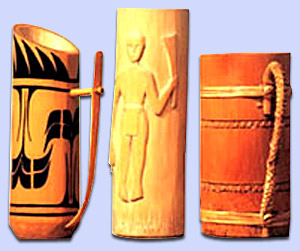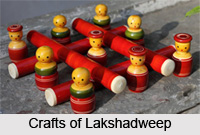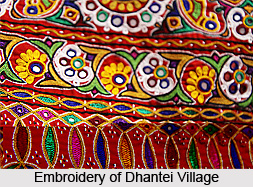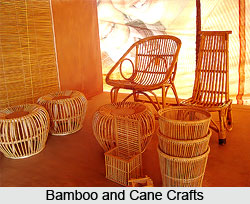 Bamboo and Cane Crafts of Mizoram are exquisite creations of the Mizos, the inhabitants of Mizoram. The abundance of raw material and surplus of the craftsmen has influenced the Bamboo and Cane Crafts of Mizoram to prosper. Having an ancient tradition of crafts, the Mizos are blessed with skill and artistry in this specific field. Mostly the Mizo men are involved with this craft.
Bamboo and Cane Crafts of Mizoram are exquisite creations of the Mizos, the inhabitants of Mizoram. The abundance of raw material and surplus of the craftsmen has influenced the Bamboo and Cane Crafts of Mizoram to prosper. Having an ancient tradition of crafts, the Mizos are blessed with skill and artistry in this specific field. Mostly the Mizo men are involved with this craft.
Craftsmen of Mizoram
The people of Mizoram are skilled in crafting a variety of beautiful and useful items that glorify the Bamboo and Cane Crafts of Mizoram. Mizos make different use of fibers and leaves of bamboo and cane to create different artifacts. In addition to baskets, weaving tools, umbrella-handles, mugs, smoking pipes and toys, this craft also finds utility in making furniture, which includes sofas, chairs, tables, moorhas and many more. Besides these, the Mizo people use bamboo extensively to make their houses. Sometimes, even the floors and walls of the houses are also made up of bamboo.
Bamboo and Cane Crafts
The craftsmanship of the Mizos in bamboo and cane crafts is best displayed in the variety of baskets which come in different shapes and sizes and are easily found in different locations of the state. These baskets serve different purposes. Broad baskets are meant for storing cotton, vegetables, firewood, etc whereas the closed ones are used for storing grains. The salmagundi of cane and bamboo products of Mizoram are crafted at the three different centers of handicraft located in Lunglei, Aizwal and Chimptuipui.
Exclusive designs of hats, made of cane, and different types of animal and fish traps, made of bamboo, are also a specialty of Mizoram. For storage purpose, other items like bamboo cones, japis and circular boxes are also crafted. Mizo people are very fond of the beautiful jewellery made out of bamboo. One of the well known bamboo ornaments of Mizoram is traditional headgears which are very popular among the people of Mizoram. Thlangra or winnowing tray is another unique craft which only a few skilled craftsmen can make. Recently artisans have also started making bamboo coffins to save trees.
Mizoram is very rich in terms of bamboo resources and 57% of its geographical area is covered by bamboo. About twenty species of bamboo have been identified in Mizoram among which "Meloccana baccifera" is the most dominant one. With an abundant water supply, bamboo trees grow very easily in all environmental conditions.
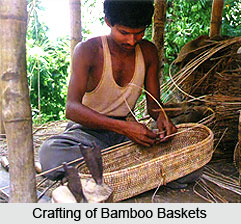 Initiatives of State Government
Initiatives of State Government
To encourage and develop the bamboo and cane craft, the Government of Mizoram has established Bamboo Development Agency. It basically aims at initiating, organizing, assisting and encouraging this art and helps in resource management by carrying out research, development and plantation of bamboo trees. The agency is effective since 9th January 2002 and has played a crucial role in promoting this art.
Bamboo Day Celebration
Another initiative had been taken by the State Government to develop and encourage the Bamboo and Cane Crafts of Mizoram. On 3rd March 2012, Bamboo Day was observed for the first time. The celebration included sale and exhibition of bamboo products with an objective of promoting bamboo based industries of Mizoram.
Bamboo and Cane Crafts of Mizoram are excellent examples of exquisite artistry. They play a significant role in the economy of the state. But due to inadequate infrastructure like logistics, electricity, roads etc, this beautiful art is still unexplored by many parts of the world. The State Government is making huge efforts to enhance the availability and popularity of the Bamboo and Cane Crafts of Mizoram in the Indian as well as international market. Though there is a substantial market of cane and bamboo products, owing to the high demand of handmade ethnic items among the tourists, the artisans of this state still need a touch of education to promote their crafts in the market.



